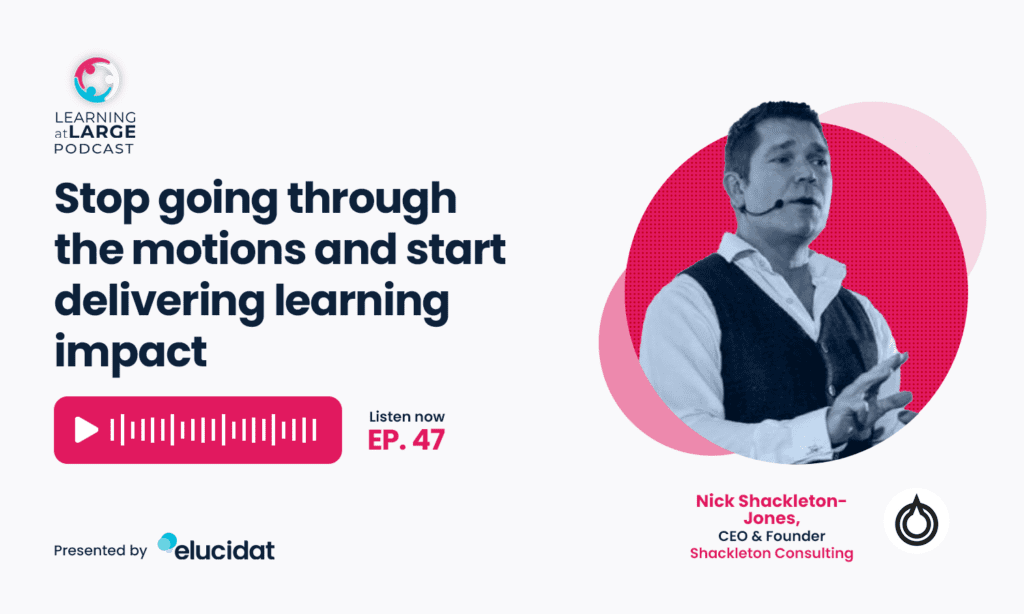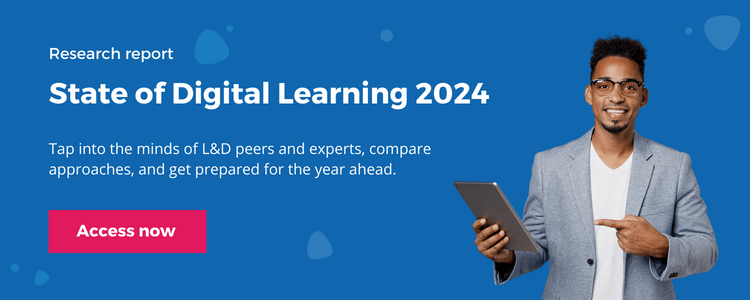Deliver Learning Impact: Nick Shackleton-Jones
It’s an open secret that businesses throw huge sums of money at training that is often grossly ineffective. If we’re going to stop this collective madness, Nick Shackleton-Jones, CEO and Founder of Shackleton Consulting, believes we need to change the way we think about learning. Find out why you need to start questioning the conventions. Explore how to get your stakeholders on board with a better alternative. Dive into his tips and strategies for delivering high-impact learning experiences.

Top tips for delivering learning experiences with impact
Don’t have time to listen now? Here are some top tips from Nick:
- Shift from education to learning: Huge budgets are being spent on ineffective training. Stop going through the motions. Start focusing on impact.
- Design experiences, not just content: To think is to feel. Create learning experiences that engage rather than content employees must consume.
- Show the business an alternative: People request more ‘education’ because they don’t know any different. Show them there’s a better alternative.
- Put people at the heart of the process: Learning will only happen if people need it. Keep your audience at the front of your mind throughout your design process.
1. Shift from education to learning
Every year vast sums of money, time and resources are spent on training. But the results are often lackluster or even completely ineffective.
Nick gives the example of an organization that spent 1.5 million every time they ran their induction program. They put people in a hotel for two weeks at a time. Key information was provided in PowerPoint presentations. When Nick asked them what output they wanted from the program, the stakeholders didn’t have an answer. They were happy to spend money going through the motions.
“I think we’ve fallen into a kind of collective madness in the training industry. It’s an open secret that we’re throwing huge sums of money at something which is grossly or completely ineffective in most cases. So it will be limiting if you don’t [ask the question: what is learning?], ultimately, you’ll just be trapped within a set of conventions and norms.”
2. Design experiences, not just content
Demand for training remains at an all-time high. Under pressure from the business, it can be easy to slip into the role of training order taker. But Nick is clear that L&D needs to move in a different direction.
Simply putting people in a classroom, providing new L&D platforms or delivering more digital learning won’t help employees develop skills or change their behavior. At the heart of this issue is falsely separating out thinking and feeling. If you don’t want to see your investment wasted, design learning that engages instead of content that employees must consume. Challenge them. Create a reaction. Transform people through an experience.
“Thinking is feeling. Plato, Descartes, all the way up to Kahneman and Dennett just led us down a blind alley. There was this stupid idea that Plato introduced that thinking and feeling are different. And we’ve been lumbered with this prejudice – as an example, women are less capable in some respect because they’re more emotional. This is not true. We only have emotional systems. All cognition is affected by nature. Thinking is just fancy feeling.”
3. Show the business an alternative
It’s clear that the demand for traditional education won’t decrease any time soon. So, how do you shift the focus to learning? Nick says there’s no point in just having a conversation. You need to show them better alternatives.
When he was working at the BBC, Nick found that, like many organizations, L&D was overwhelmed with demand for digital learning. They created a service catalog to enable them to triage these requests. At the high end, there was the experiential learning that L&D would own. In the middle, there was rapid development and co-created content. At the bottom were user-generated or self-managed resources. Armed with this catalog, he could provide options and show examples.
“The idea is you stop people – stakeholders, clients, the business – at the point they say, ‘we need a course’. And let’s not be rude about our clients. We exist to serve the business. The reason they come to us and say, ‘we need a course’, and ultimately, we start to feel like order takers, is because all they’ve known is education. That’s what they think we do. They think they understand our role and what we do. And unless we demonstrate – show not say – something better or different, why wouldn’t they?”
4. Put people at the heart of the process
Development in its true sense isn’t about one-off training events. It’s about giving people opportunities to learn. That’s why Nick is passionate about putting people at the heart of the learning design process.
Get out on the shop floor and find out what your employees need to do their jobs. Understand when and how they prefer to learn. Explore what will help them feel supported as they develop. By focusing on your learners, you can start shifting from providing ineffective education to impactful learning.
“A big thing is actually talking to audiences, because that’s not what happens when you go to school, right? You know, at school on day one, nobody says, ‘What are you interested in? What are you excited about? What do you really care about? What’s your future vision? Right, we’re going to design stuff around that.’ That would then start to look like learning. Instead, the curriculum has been designed by the authorities and you’re subjected to it. Nobody cares what you think, or what matters to you. So, it ends up not being learning at all. So, you shift from education to learning by putting your audience – the people that you’re designing for, your customers, if you like – at the heart of the design process.”
A quick recap
Tired of L&D going through the motions, Nick has four strategies for changing the way we think about training and delivering high impact learning experiences.
- Stop going through the ritual of providing education and start focusing on delivering impact.
- Design learning experiences that engage rather than content to consume.
- Don’t just tell your stakeholders that education isn’t the right approach, show them a better alternative.
- Make your learners the center of your learning design process.
Want to find out more? Check out the full podcast.
About Nick
With over 20 years’ experience in L&D working for organizations like the BBC, BP and Deloitte, Nick set up Shackleton Consulting in 2021. A new edition of his book How People Learn came out this year and provides an updated look at how we think about learning.
You can find out more and get connected with Nick on LinkedIn.
On Nick’s reading lists
Find out which books from other fields have inspired Nick’s thinking about learning and development.
The World Until Yesterday: What Can We Learn from Traditional Societies? Jared Diamond
This book looks at how learning has happened for millennia. Nick finds it a fascinating glimpse into what it would be like if humans hadn’t imposed formal education.
The Power of Moments: Why Certain Experiences Have Extraordinary Impact, Chip Heath, Dan Heath
Why do certain brief experiences jolt, elevate and change us? This book explores how we can learn to create such extraordinary moments in our own life and work.
You can also check out Nick’s new book by clicking here: How People Learn: A New Model of Learning and Cognition to Improve Performance and Education.
Looking for more reading tips? Check out our book blog.
Learn more from like-minded learning experts
Interested to hear more from Lori as well as other learning experts and your L&D peers? The State of Digital Learning Report is the place where you can tap into the minds of your L&D peers and learning experts, compare approaches, and get prepared for the year ahead.
